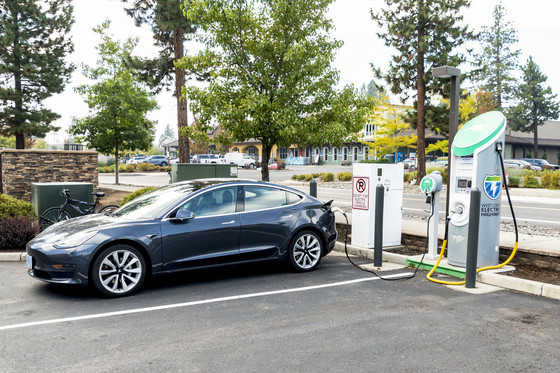How will ODOT spend $52 million for electric vehicle charging from the federal infrastructure bill?
 December 7, 2021
For more information, contact Matt Noble, ODOT PIO: 503-779-9868
This release is the first in a series that will provide more information on how ODOT plans to spend funding from the federal Infrastructure Investment and Jobs Act.
SALEM – Oregon’s electric vehicle infrastructure is about to get supercharged.
The state is set to receive $52 million of additional funding over the next five years for EV charging infrastructure. The money is part of the $1.2 billion in additional transportation funding from the recently passed federal infrastructure package.
The federal government makes the initial decisions on how that $52 million can be spent. ODOT should receive the first set of federal guidelines in February 2022.
Suzanne Carlson, ODOT Climate Office director, says her office expects the federal guidelines will steer the funding to Alternative Fuel Corridors, which are national highways that are eligible for federal grant funding to add public EV charging and other alternative fuel infrastructure. The program is overseen by the Federal Highway Administration.
Oregon has seven corridors designated under the program: Intestates 5, 84 and 82, and U.S. 26, 101, 20 and 97.
Partnerships
Forming public-private partnerships to award the funding may be a key component, based on past rounds of federal funding.
ODOT already has experience here. Earlier this year, ODOT invested $4.1 million to support EV Charging Solutions’ upgrades to Oregon’s slice of the West Coast Electric Highway.
The agency also partnered with local firms Forth, Kittelson & Associates, and Rocky Mountain Institute to complete a future electrification needs study in 2020-21, which examined Oregon’s EV charging needs over the next 15 years.
Jeff Allen, Forth’s executive director, is optimistic about Oregon’s EV future.
“Oregon's early leadership and hard work means we are extremely well-positioned to make good use of this federal funding to build out a charging network that will make it easy for Oregonians to drive electric wherever they go across the state,” said Allen.
Prepared for future charging needs
According to ODOT data, Oregonians are adopting EV’s at a swift rate. New EV registrations in 2021 are on track to increase by about 70 percent compared to 2020.
It’s a similar story with electric bicycles: the New York Times reported national e-bike sales jumped 145 percent from 2019 to 2020.
That increased adoption rate coincides with results from ODOT’s future electrification needs study, which presents a clear roadmap for ODOT and partners to follow to electrify the system for multiple types of vehicles.
“With the study’s findings, we can be more strategic and keep up momentum on EV adoption rates,” said Carlson. “Our role will be to make targeted state investments, secure more federal grant funding, and make sure public EV charging is equitable and practical.”
Transportation electrification is high on the agency’s list of strategic priority outcomes, and is a key component in state government’s effort to reduce greenhouse gas emissions from transportation. About 40% of the state’s total GHG emissions come from the transportation sector, including freight and aviation.
“Moving quickly to electrify transportation is just one piece of Oregon’s emission reduction plan,” said Carlson. “Together with other ongoing investments in bike and pedestrian programs, public transit, and climate resiliency, we’ll be able to make strong progress on our work to address climate change in Oregon.”
ODOT has released an infographic and recorded a webinar that describes what Oregon expects to receive from the federal funding package in more detail. Those materials can be found here: https://www.oregon.gov/odot/Pages/IIJA.aspx
|